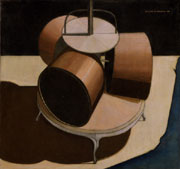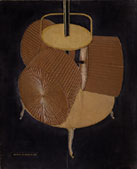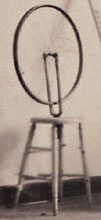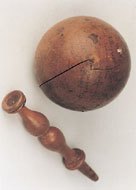|
click
to enlarge
|
|
|
|
Figure
20
|
|
Marcel
Duchamp, Coffee Mill, 1911
|
As Time Goes
By: The Passage from Pendu(lum) to Chronograph
The first and only
other instance when these chronophotographic cues significantly come
into play is Duchamp's pseudo-plan and -elevation of the Coffee
Mill (1911) (Fig. 20), where, as in
the second Nude, they again plot a specifically "circular"
movement. This is the same (meta)physical trajectory--which, of course,
is not one(33)--that
Duchamp's two versions of the Chocolate Grinder (1913; 1914)
(Fig. 21a, b) and, more famously, his Bicycle Wheel (1913) (Fig. 22) also share. In
addition to their common trajectory, however, the Coffee Mill and Chocolate Grinder also share a common morphology:
from the knobbed handle of the Coffee Mill, which traces a circle
about its stationary rod; to the three cylinders of the Chocolate
Grinder, which also rotate about a stationary rod--one which is,
itself, capped with a circular head, and not so enigmatically called
the "bayonet" (DDS 96; WMD 68), if we again
think of Marey's fencers' foils; finally, to a bicycle wheel which,
in the title work, is mounted to another stationery rod--this one (like
"Le Pendu Femelle" in the second Nude, Passage
and Bride), by contrast, forked. If we add, as post-scripts,
Duchamp's experiments with the Rotary Glass Plates (1920)
(Fig. 23) and Rotary Demisphere (1925)
(Fig. 24), which figure the same sort of
rod-and-demisphere apparatus spinning on axis, the fact of a common
morphology to all these variegated objects becomes evident, as does
its formal prototype in the work which Francis Naumann suggests might
be Duchamp's first Ready-made: Bilboquet (1910) (Fig.
25), a variation on the traditional cup and ball game, which
if correctly manipulated, exactly consists of a ball perched upon a
rod. Indeed, the vicious circles all these rods variously describe,
or are otherwise inserted into, like the sexual coupling Bilboquet
assumes in particular,(34)
even anticipate Giacometti's own "pendu"(lum) of sexual frustration,
Suspended Ball (1930) (Fig. 26).
|
click
on images to enlarge |
|
|
|
|
Figure
21a
|
Figure
21b |
Figure
22
|
|
Marcel
Duchamp, Chocolate Grinder, No. 1, 1913
|
Marcel
Duchamp, Chocolate Grinder, No. 2, 1914
|
Marcel
Duchamp, Bicycle Wheel, 1913
|
click
on images to enlarge |
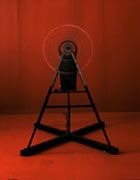 |
|
|
|
|
Figure
23 |
Figure
24
|
Figure
25 |
Figure
26
|
|
Marcel
Duchamp, Rotary Glass Plates, 1920
|
Marcel
Duchamp, Rotary
Demisphere,
1925
|
Marcel
Duchamp, Bilboquet,
1910
|
Alberto
Giacometti, Suspended Ball, 1930
|
| click
to enlarge |
| |
| Figure
27 |
|
Marcel
Duchamp, The Chocolate Grinder's Leg, 1914, from the Green
Box (1934)
|
In addition to their
circular trajectory, however, the Coffee Mill and Chocolate
Grinder are also productive of the same scatological-type comestibles,
and in this sense participate in the same bodily metaphor: "Slow
life--Vicious circle--Onanism..." (DDS 82; WMD 56),
as Duchamp laments in his Large Glass dirge. Even without the
dirge, however, the embodied onanism of Duchamp's "circular"
imagery is not exactly subtle. "Always there has been a necessity
for circles in my life", he explains, for "rotation. It is a
kind of narcissism, this self-sufficiency, a kind of onanism".(35)
In exactly these terms, indeed, Bruno Bettelheim describes how one of
his similarly circle-obsessed patients, "Joey", "moved
his penis as if it were the handle of a machine and called it 'cranking
up the penis'".(36)
(Like the crankshaft of the Model-T Duchamp could neither drive nor marry
and, faute de mieux, the automobile heiress whom he did marry,(37)
but soon only drove on Sundays?) Yet what the Coffee Mill and
Chocolate Grinder add to the morphological mix is exactly this--an
explicitly phallic "crankshaft": self-evident in the alternately
detumescent, tumescent and outright saluting sweep which the Coffee
Mill's knobbed "handle" traces; no less evident, however,
in the "nickel-plated Louis XV chassis" on which Duchamp "mounts"
his beloved-of-youth (if, perhaps, then G-Rated) Chocolate Grinder
(DDS 97; WMD 68). For "she"--"[La] Broyeuse
de chocolat" [The Chocolate Grinderess], as Duchamp calls
her, already a very strangely marked type of what would simply appear
to be "un broyeur"--ain't no lady. Not only is she "montée"
[mounted] to her chassis, but how she is "montée"
[hung]. Indeed, that Louis XV decor should ever have such Size-Queen-Anne
"legs" (Fig.
27)--formidable! The only difference, then, between the Coffee Mill's knobbed "handle" and the Chocolate Grinder's
cabriole "legs" is whether the body of the mechanomorphic apparatus
prefers to crown itself at top with a time-lapse whirligig of lesser phalli,
or to ride them instead like so many carousel horses: the casters with
which, in a sheerly gratuitous gesture even for Duchamp, he supplies the
second Chocolate Grinder's "legs".
But for all her
great good luck, just like the modus (non) operandi of the Large Glass "Bride", the Chocolate Grinder's is also the
tale of an affection she does not exactly requite, as Duchamp describes:
|
sur
un châssis Louis XV = sur un[e] chasse: il lui quinze
during the chase: fifteen times [she]
nickelé
= niques, elles, [f]ait
thumbs that nose of hers at him
|
| click
to enlarge |
| |
|
Figure
28 |
|
Salvador
Dalí, Persistence of Memory, 1931
|
Yet the perhaps ball-busting
Chocolate Grinder is no lady in this sense as well. For the viciously-circular
bodily metaphor she figures is, in itself, an endlessly-sweeping clockwork
metaphor: a sort of sexual end-game gone terribly wrong and instead become
a waiting-game--or, more to the point, a kind of Crying Game (as
in "Le Pendu Femelle" after all...). Thus the
"circularity" of the Coffee Mill and Chocolate Grinder
refers not only to the not-so-merry-go-round of onanism--"éternullité",
as Jules Laforgue says in his vein splittingly funny way(38)--but
also to the circular movement of a clock, as does "Le Pendu Femelle"
which is both "femelle" [la "pendu...le" = clock],
yet grammatically masculine ["le pendu...le" = pendulum]. Indeed,
the so-called first "Blossoming" of the "Bride"--which,
in the upper register of the Large Glass, includes "Le Pendu
Femelle"--"should graphically aim", says Duchamp, "at
a clockwork movement (electrical clocks in railway stations)... to develop[:]
how best to express the throbbing jerk of the minute hand" (DDS
64; WMD 43). With its source, then, not only in the type of "rotation
and sexual movement" which Bataille similarly identifies to locomotives,
but also in the sort of clock we specifically find in "railway stations"
-- in other words, in waiting rooms--"Le Pendu Femelle"
indeed inaugurates the same countdown which Dalí's famous paean not just
to time waiting to get hard, Persistence of Memory (1931) (Fig.
28), by contrast, indefinitely suspends.(39)
It is not only in
relation to a clock, however, but also as another sort of measuring device,
a "barometer", that Duchamp describes "Le Pendu Femelle".
In a note entitled "In 'Le Pendu Femelle' -- and the Blossoming-Barometer",
he explains: "The filament substance might lengthen or shorten in
response to an atmospheric pressure organized by the wasp. (Filament substance
extremely sensitive to differences of artificial atmospheric pressure
controlled by the wasp)" (DDS 69; WMD 48). This "Blossoming",
by contrast, is thus effected by two principal actors. First, there is
the "baromètre" (i.e. "une barre à mettre"), of which
Man Ray's Catherine Barometer (1920), as well as his portrait
that year of Mina Loy (which prominently features a thermometer-earing),
also create something on the order of phallic mood-rings.(40)
Second, there is the "guêpe" [wasp]. However, the wasp is not
only the grammatically invariable riposte -- "La Guêpe" (femelle)
-- to "Le Pendu Femelle", but also it is the female of the wasp
that has the poisonous stinger ["aiguillon"], which is itself
a variant on the "minute hand" ["aiguille"] of the
first "Blossoming", just as the former's venomous "sting"
reiterates the latter's "throbbing jerk". No matter, then, whether
we prefer to speak of a mercurial "barre" become "longue
et rigide", as Le Robert defines it, or, instead, of a retractable
"aiguillon". At issue, either way, is the same tumescence-inducing
operation: whether of bar or stinger, a process of "lengthening or
shortening" which, in response to "differences of pressure",
the barometer and the wasp can bring to bear more or less at will. Although
Duchamp's "Blossoming" perhaps parallels the undisclosed inner
workings of Woody Allen's famous "Orgasmatron", we can be certain
that it does parallel the tumescence-inducing "mechanical woman whose
vagina, contrived of mesh springs and ball bearings, would be contractile,
[and] possibly self-lubricating", which Duchamp once proposed to
erect.(41)
>>Next
page
1 2 3 4
5 6
Notes
 32. Bruno Bettelheim,
The Empty Fortress: Infantile Autism and the Birth of the Self
(N.Y.: Free Press, 1967) 304. On the "autism" of Duchamp's
works -- including their conceptual relationship, in this sense, to
Bettelheim's "Joey" -- see Rosalind Krauss, "Notes
on the Index: Part 1", in The Originality of the Avant-Garde
and Other Modernist Myths (Cambridge, Mass.: M.I.T., 1985) 199-200;
Annette Michelson, "'Anemic Cinema': Reflections on an Emblematic
Work", Artforum, vol. 12, no. 2 (Oct. 1973): 64-69. See
also Robert Lebel, Marcel Duchamp, trans. George Hamilton (N.Y.:
Grove Press, 1959) 30, where he describes Duchamp as "entrenched
in an 'autism' which leaves no possible ambiguity".
32. Bruno Bettelheim,
The Empty Fortress: Infantile Autism and the Birth of the Self
(N.Y.: Free Press, 1967) 304. On the "autism" of Duchamp's
works -- including their conceptual relationship, in this sense, to
Bettelheim's "Joey" -- see Rosalind Krauss, "Notes
on the Index: Part 1", in The Originality of the Avant-Garde
and Other Modernist Myths (Cambridge, Mass.: M.I.T., 1985) 199-200;
Annette Michelson, "'Anemic Cinema': Reflections on an Emblematic
Work", Artforum, vol. 12, no. 2 (Oct. 1973): 64-69. See
also Robert Lebel, Marcel Duchamp, trans. George Hamilton (N.Y.:
Grove Press, 1959) 30, where he describes Duchamp as "entrenched
in an 'autism' which leaves no possible ambiguity".
 33. Cf. my "Meret
Oppenheim -- or, These Boots Ain't Made For Walking", Art
History, vol. 24, no. 3 (June 2001): 358-78.
33. Cf. my "Meret
Oppenheim -- or, These Boots Ain't Made For Walking", Art
History, vol. 24, no. 3 (June 2001): 358-78.
 34. Francis Naumann,
Marcel Duchamp: The Art of Making Art in the Age of Mechanical
Reproduction (Ghent: Ludion Press, 1999) 40-41, 57 (n. 2), where
he suggests that Bilboquet might be a souvenir of a bordello
visit, or perhaps of a circus act in which "La Femme Bilboquet"
was no less suggestively catapulted across the stage onto a projecting
spire. Interestingly, Steven Harris reads Claude Cahun's and Man Ray's
use of the bilboquet in the 1930s as "[playing] on castration
in the detachability of cup and ball". "Coup d'oeil",
Oxford Art Journal, vol. 24, no. 1 (2001): 103.
34. Francis Naumann,
Marcel Duchamp: The Art of Making Art in the Age of Mechanical
Reproduction (Ghent: Ludion Press, 1999) 40-41, 57 (n. 2), where
he suggests that Bilboquet might be a souvenir of a bordello
visit, or perhaps of a circus act in which "La Femme Bilboquet"
was no less suggestively catapulted across the stage onto a projecting
spire. Interestingly, Steven Harris reads Claude Cahun's and Man Ray's
use of the bilboquet in the 1930s as "[playing] on castration
in the detachability of cup and ball". "Coup d'oeil",
Oxford Art Journal, vol. 24, no. 1 (2001): 103.
 35. Roberts,
"Interview with Marcel Duchamp", p. 63
35. Roberts,
"Interview with Marcel Duchamp", p. 63
 36. Bettelheim, The Empty Fortress, p. 304.
36. Bettelheim, The Empty Fortress, p. 304.
 37. On the Large
Glass "Bride" as automobile, see n. 73, herein.
37. On the Large
Glass "Bride" as automobile, see n. 73, herein.
 38. See
Golding, Marcel Duchamp, p. 25.
38. See
Golding, Marcel Duchamp, p. 25.
 39. Duchamp's
La Pendule de Profil (1964) is exactly "Le Pendu Femelle"
both become a clock [une "pendu...le"] (cf. DDS 47;
WMD 31), yet one which, according to Duchamp, "no longer
tells the time" (Arturo Schwarz, The Complete Works of Marcel
Duchamp (NY: Delano Greenidge Editions, 2000) 845).
39. Duchamp's
La Pendule de Profil (1964) is exactly "Le Pendu Femelle"
both become a clock [une "pendu...le"] (cf. DDS 47;
WMD 31), yet one which, according to Duchamp, "no longer
tells the time" (Arturo Schwarz, The Complete Works of Marcel
Duchamp (NY: Delano Greenidge Editions, 2000) 845).

|
click to enlarge
|
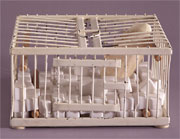 |
|
Figure 29
|
|
Marcel Duchamp,
Why Not Sneeze Rose Sélavy, 1921
|
40.
Duchamp's Why Not Sneeze Rose Sélavy (1921) (Fig.
29) materializes
the same cold, dry conditions which Man Ray's Catherine Barometer
parodies: the former, created for Dorothea Dreier; the latter, as
a joke at the expense of her sister Katherine. Thus, the cold-as-marble
cubes, which Duchamp includes, are unable to cause the thermometer
even to rise, let alone to create the sort of tickle which only a
good sneeze (or another spasm, also of the involuntary sort) can hope
to relieve. To its coldness, the cuttlebone [cuttlefish = "seiche"],
which Duchamp also includes, merely adds a sense of aridity ["sèche"]
and, in this way, doubly describes both the object's patron [Dreier
= drier] and its title subject: "Voici le domaine de Rrose Sélavy
/ Comme il est aride -- Comme il est fertile -- Comme il est joyeux
-- Comme il est triste" [Here's where love lives. How dry it
is -- and fertile. How joyous it is -- and sad]. Schwarz, The Complete
Works of Marcel Duchamp, p. 900 (n. 23). Cf. Albrecht Dürer's
Melencolia I (1514), where the melancholic elk and its referent
in black bile also symbolize the artistic process as essentially "cold
and dry".
 41. Calvin Tomkins,
Duchamp: A Biography (N.Y.: Henry Holt, 1996) 276, quoting
Julien Levy, Memoir of an Art Gallery (1977).
41. Calvin Tomkins,
Duchamp: A Biography (N.Y.: Henry Holt, 1996) 276, quoting
Julien Levy, Memoir of an Art Gallery (1977).
Figs. 20-27, 29
©2003 Succession Marcel Duchamp, ARS, N.Y./ADAGP, Paris.
All rights reserved.
|

